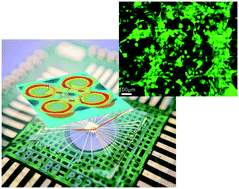A microelectrode array chip for osteogenic differentiation of mesenchymal stem cells under electrical stimulation†
Abstract
Electrical stimulation (ES) as an easy and effective inducing method has been widely used in induction differentiation of stem cells, e.g. osteogenic differentiation of mesenchymal stem cells (MSCs) for bone healing and bone tissue therapies. However, the micro-effect of an inhomogeneous electric field has rarely been investigated for ES in induction differentiation, and conventionally used ex situ assays may preclude accurate assessment due to variation from cell inoculation and treatments. Here, a novel electrical stimulation method with a microelectrode array chip is proposed for osteogenic differentiation of MSCs. The electric field applied onto the MSCs by the microelectrode array is designed similarly with a natural aggregation distribution of differentiated MSCs. The proposed ES method accelerates osteoblast proliferation and differentiation in the electrode array region and generates a larger amount of mineralized deposits, which are assayed via in situ alizarin red staining and morphology observation as well as immunocytochemistry. In addition, this method allows a direct in situ assessment to compare the osteogenic differentiation of MSCs with and without ES on a single chip to avoid culture environment difference. The method provides a fundamental platform for investigating induced differentiation of stem cells and allows integration with multifunctional cell assays to achieve in situ tracking for the differentiation process of stem cells.



 Please wait while we load your content...
Please wait while we load your content...